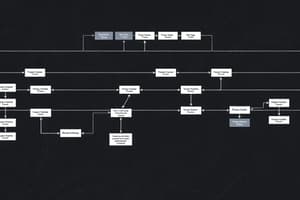Podcast
Questions and Answers
What is the purpose of walking through the map step-by-step after it has been created?
What is the purpose of walking through the map step-by-step after it has been created?
- To ensure all team members understand the process (correct)
- To create an electronic version of the map
- To document the process for reference
- To identify unnecessary steps in the process
What should be done with the revised map after team review?
What should be done with the revised map after team review?
- It should be stored for future reference only
- It should be discarded and a new map created
- It should be used immediately without further changes
- It should be distributed to a larger group for review (correct)
What is the benefit of having a simple process map?
What is the benefit of having a simple process map?
- It is more complex and detailed
- It is only used by experts
- It is easier to understand and use (correct)
- It serves no purpose
Why is it important to document the process map?
Why is it important to document the process map?
What is the purpose of process mapping?
What is the purpose of process mapping?
What should be done with unnecessary steps in a process?
What should be done with unnecessary steps in a process?
What should be done after making changes to the process map?
What should be done after making changes to the process map?
Why is it important to involve many people in the process mapping exercise?
Why is it important to involve many people in the process mapping exercise?
What is the benefit of reviewing the process map with the team?
What is the benefit of reviewing the process map with the team?
What should be done with the feedback received from the larger group review?
What should be done with the feedback received from the larger group review?
Flashcards are hidden until you start studying
Study Notes
Introduction to Process Mapping
- Process mapping is a critical exercise for companies to function and improve, regardless of their efficiency or effectiveness.
- It helps ensure a firm foundation for a company, especially when automating, reorganizing, improving performance, merging, acquiring, or selling a business.
- Many organizations fail to address and document their business processes, assuming that everyone understands them, but this is rarely the case.
Benefits of Process Mapping
- Process mapping creates a single format for all business processes, making it easier to capture, analyze, and improve the way a business works.
- It provides a graphical representation of complex or abstract ideas, facilitating understanding and communication.
- A process map helps identify who performs tasks, who is the business owner, how long tasks take, what resources are used, and what value is created.
- It delivers a shared understanding and overview of what is involved in a process.
Common Steps in Process Mapping
- Plan the mapping effort, defining the process to be mapped and its boundaries, including triggers, outputs, and level of detail.
- Form and train the mapping team, considering process complexity, organizational and individual teams involved, and time and cost issues.
- Conduct the mapping session, collecting and analyzing information about the process.
- Review and revise the process map, ensuring it accurately captures the process and incorporating feedback from stakeholders.
Stages of Process Mapping
- Plan the mapping effort, defining the process and its boundaries.
- Form and train the mapping team, considering process complexity and organizational teams involved.
- Conduct the mapping session, collecting and analyzing information about the process.
- Review and revise the process map, ensuring it accurately captures the process and incorporating feedback from stakeholders.
Process Mapping Elements
- Process inputs, outputs, action steps, and performers should be included in all process maps.
- Optional elements include time required to complete each step, feedback to the performer, systems, data elements, business rules, and work environment.
Reviewing and Revising the Process Map
- Distribute copies of the map to the team for individual review and feedback.
- Meet to confirm that the process was accurately captured and note any changes that need to be made.
- Revise the process map based on feedback and distribute the revised map to a larger group for review.
- Use the feedback received to revise the process map as needed, making it ready for use and circulation.
Studying That Suits You
Use AI to generate personalized quizzes and flashcards to suit your learning preferences.




